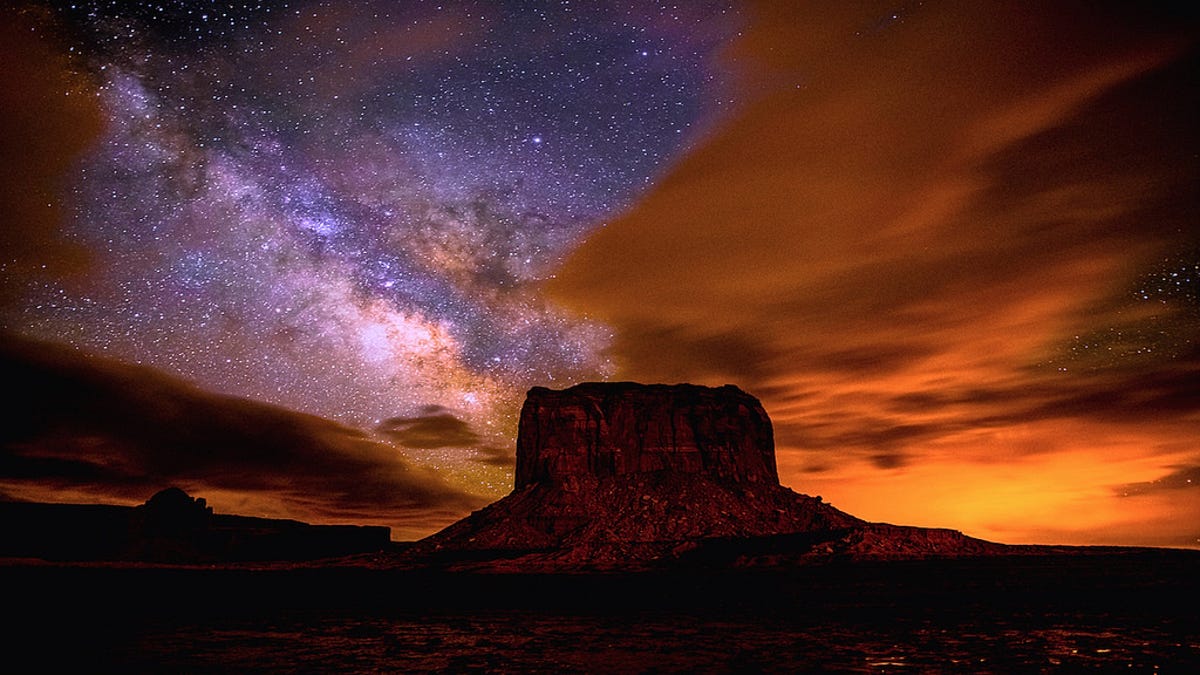Cosmic beauty, photographed from the desert (pictures)
Two photographers and their students brave threatening weather in Arizona to capture these stunningly beautiful pictures of our galaxy.

Beautiful butte
When photographer Gavin Heffernan teamed up with his old film school classmate, Northern Arizona University professor Harun Mehmedinović, the two headed out to the Arizona countryside to create a series of stunning time-lapse images and a video called Yikáísdáhá, the Navajo word for the Milky Way.
This shot was taken in Monument Valley Navajo Park and shows the Milky Way on the left seeming to converge with storm clouds on the right lit by the sun's last rays.
"The weather was very intense at times, with high winds, frigid temperatures, and storm fronts passing over us, but the locations were absolutely stunning and the clouds parted for long enough to reveal some incredible starscapes, meteors, and the clearest Milky Way I've ever seen," Heffernan says on his Vimeo video page.
See related article: Stars, Milky Way captured in stunning time-lapse photos and video
Star swirl
This shot, taken in the Grand Canyon, uses the star Polaris as its focal point to create the unique swirling pattern.
"This essentially traces the rotation of the Earth, as it rotates over a 3-4 hour period," Gavin Heffernan told Crave. "Where you place the camera dictates the general shape. For the circling, spinning effect, the North Star Polaris is at the center of the frame, and the Earth spins perfectly around it, creating the dizzying circle effect. Aiming in other directions gives the sweeping left to right, or up and down trails effects."
See related article: Stars, Milky Way captured in stunning time-lapse photos and video
Milky trees
"For those who were asking, the crazy burnt out forest seen in the Milky Way shots is all in Grand Canyon National Park, a much more diverse location than I imagined," Gavin Heffernan says of this shot on his Vimeo page.
See related article: Stars, Milky Way captured in stunning time-lapse photos and video
Explosive sun
Worthy of an opening scene in a sci-fi film, this shot of a butte in Monument Valley makes the setting sun look like a giant explosion on the horizon.
See related article: Stars, Milky Way captured in stunning time-lapse photos and video
Alternate universe?
No, there's no where on Earth where the stars really move like this.
According to Gavin Heffernan, this shot used "artistic license" and was "created using a mirroring effect and other distortions in Final Cut."
See related article: Stars, Milky Way captured in stunning time-lapse photos and video
Meteor breakthrough
This still from the video captures a meteor appearing in the night sky.
In the notes about the film, Gavin Heffernan writes: "The great Phil Plait at Slate explains in his Bad Astronomy blog: 'At 2:10 in, a meteor flashes, and leaves behind a curling wisp of what looks like smoke. This is called a persistent train, the vaporized remains of the meteoroid itself, and can glow for several minutes. The upper level winds from 60 – 100 km above Earth's surface are what blow it into those curlicues.'"
See related article: Stars, Milky Way captured in stunning time-lapse photos and video
Star light, star bright
The stars seem to burst from the horizon in this colorful shot of star swirls at dusk.
"Most night shots were captured at 25-second exposures on our Canon EOS 6D's and Canon 5D mk3's with a variety of wide, fast lenses," Gavin Heffernan says on his video page. "Because the nights we picked had almost zero moon, the stars and Milky Way were exceptionally clear (once the storm clouds parted), which also made a perfect galactic palette for some star trails experiments."
See related article: Stars, Milky Way captured in stunning time-lapse photos and video

